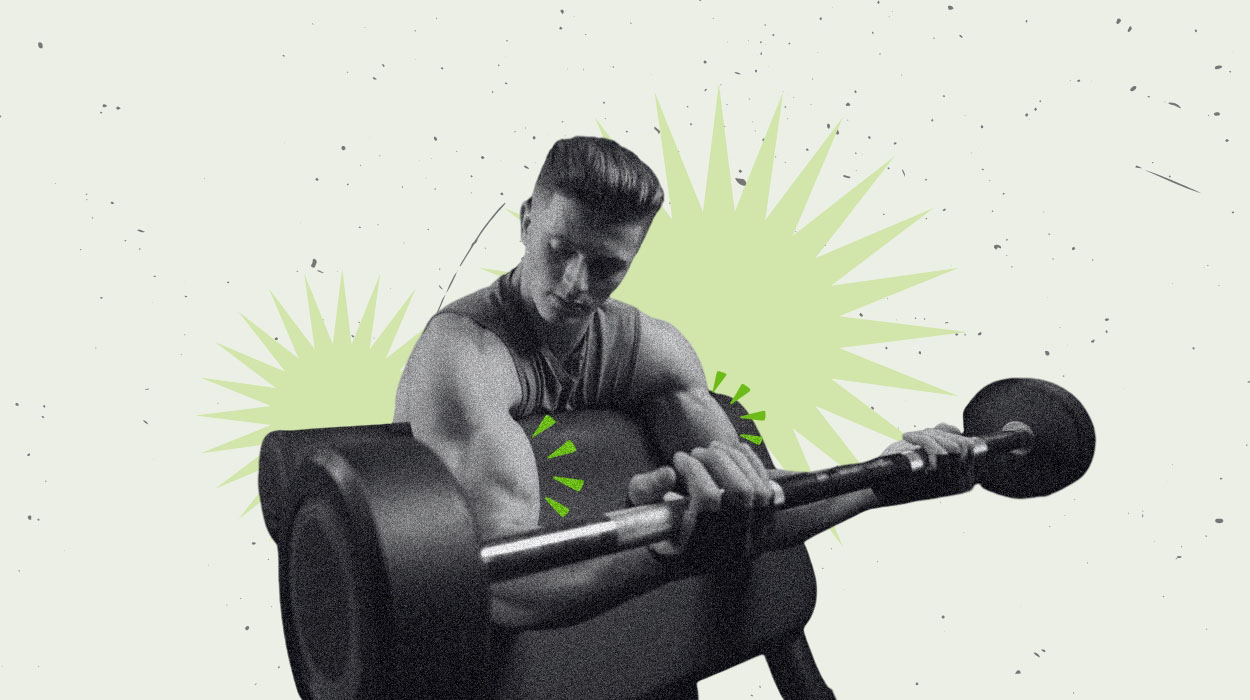
If you are ready to strengthen and sculpt your arms like never before, a barbell arm workout may be your answer. Whether you want to build bigger biceps and triceps or just start your fitness journey, these exercises can fit your needs.
For even better results, consider adding these quality supplements or a fat burner to accelerate weight loss and provide powerful nutrients.
So, if you have been focusing on a dumbbell arm workout for mass, get ready to take it to a new level with an arm workout with a barbell. Let’s dive in and discover how to get the sculpted arms you’ve always wanted!
Barbell Exercises For Arms To Train Your Biceps And Triceps
Here is a list of barbell workouts for arms to help strengthen and build your biceps and triceps:
Best Barbell Arm Workout For Building Arms
Barbell exercises are among the most effective and versatile options when building strong, well-defined arms. From targeting the biceps and triceps to engaging the forearms, these barbell arm exercises will help you achieve the sculpted lower and upper arm areas. These arm workouts are helpful for both men and women.
Let’s explore seven powerful exercises for your arm muscles and learn how to execute them with proper form for maximum results and more muscular arms.
Barbell Close-Grip Bench Press
The barbell close-grip bench press is a highly effective compound exercise that primarily targets the triceps while also engaging the chest and shoulders. By bringing your hands closer together on the barbell, you emphasize the triceps muscles more than a traditional bench press.
This exercise is fantastic for building triceps strength and size, contributing to improved pressing power and overall upper-body development. Additionally, it can enhance your performance in various pushing movements and help you achieve well-rounded arm strength. Incorporating the close-grip bench press into your barbell arm workout can lead to improved arm aesthetics and functional upper-body strength.
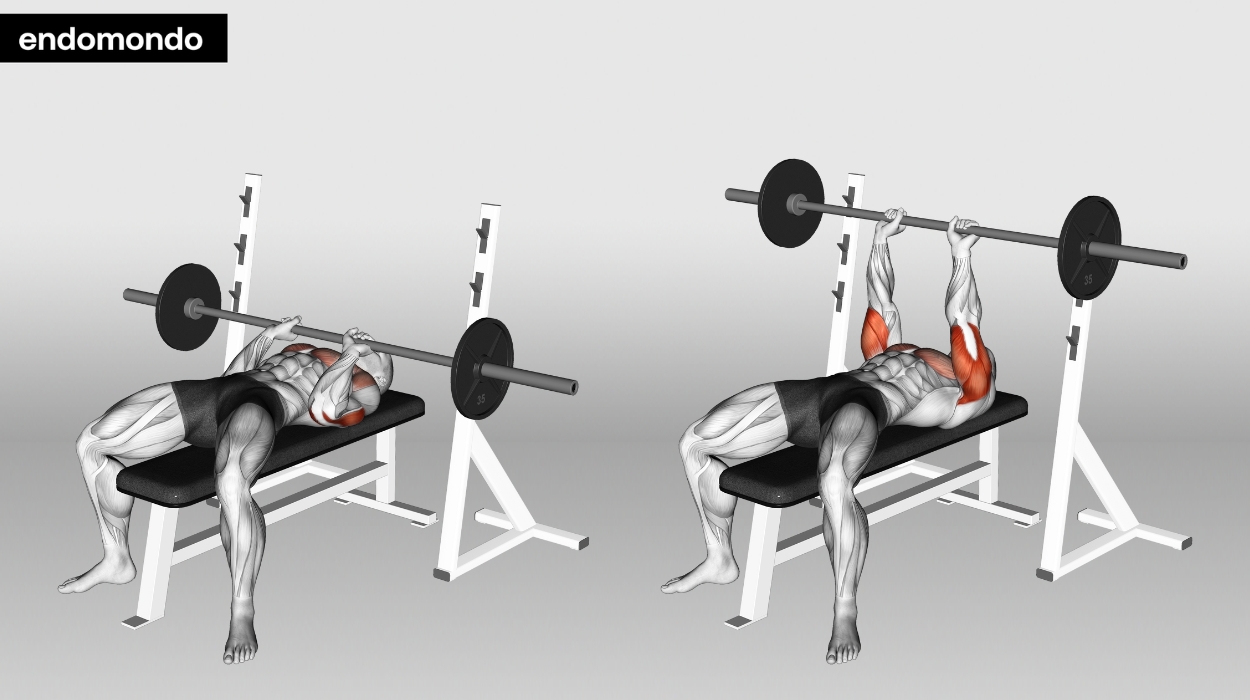
How to do:
- Lie on a flat bench with your feet on the ground.
- With your hands placed closer than shoulder-width apart, grip the barbell.
- Slowly lower the barbell to your chest while keeping your elbows close to your body.
- Push the barbell back up to the starting position by fully extending your arms.
Tips:
- Avoid using excessive weight that compromises your form and control.
- Keep your elbows close to your body as you lower and lift the barbell to avoid straining the shoulders.
- Maintain a steady and controlled tempo throughout the exercise.
Optimal Sets and Reps: 2 to 3 sets of 8-12 reps.
Barbell Reverse Curl
The barbell reverse curl focuses on the forearm muscles, primarily the brachioradialis. It also engages the biceps for a well-rounded arm workout.
This exercise is excellent for developing forearm and grip strength, which is crucial for various daily activities and sports. It can also contribute to more balanced arm development by targeting the often-neglected brachioradialis. In short, the reverse curl can improve forearm aesthetics, enhance grip strength, and better overall arm strength and function.
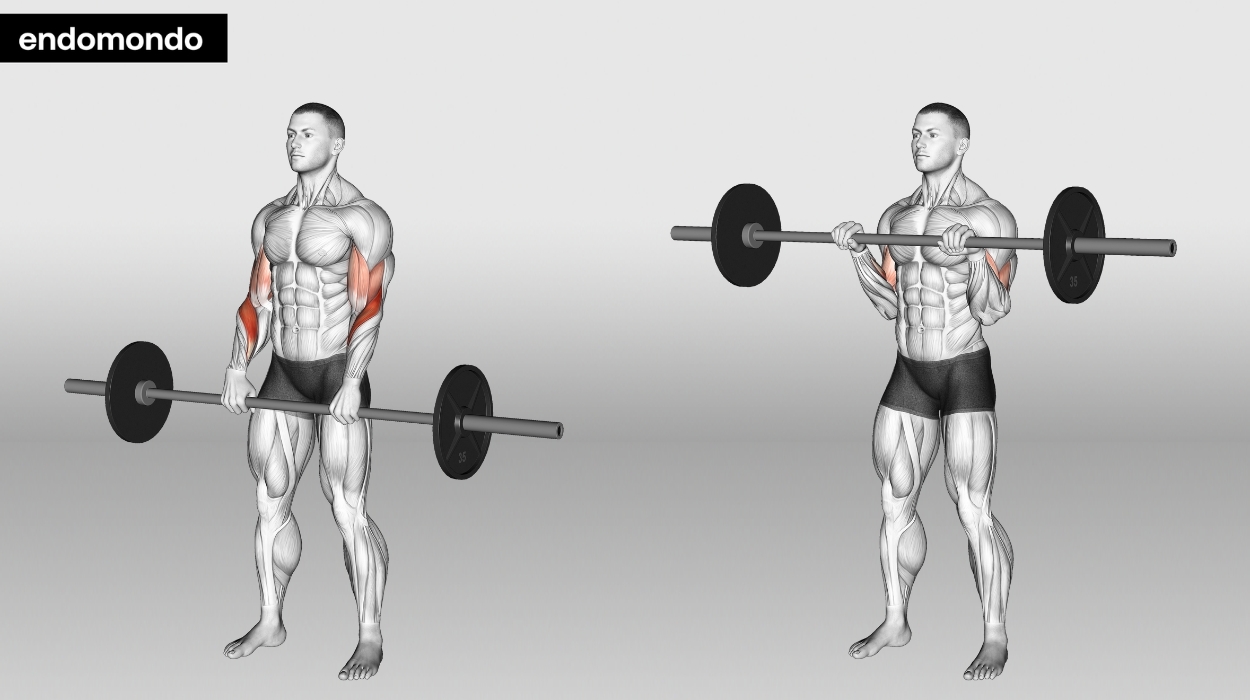
How to do:
- Stand with your feet at shoulder-width while holding the barbell with an overhand grip.
- Keep your elbows close to your sides and hands shoulder-width apart.
- Using only your forearms, slowly curl the barbell toward your shoulders.
- Slowly lower the barbell down to your original starting position.
Tips:
- Avoid swinging or using momentum to lift the barbell; instead, use only your forearm and elbow strength to raise the weight.
- Lift and lower the barbell in a slow and controlled manner, emphasizing the contraction of the forearm muscles.
- Focus on using a manageable weight that allows you to perform the exercise with proper control and technique.
Optimal Sets and Reps: 2 to 4 sets of 10 reps with a moderate weight or 6-8 reps with a heavier weight.
Barbell Spider Curl
This isolation exercise primarily targets the biceps brachii, using a focused and intense contraction to help support biceps muscle development.
The barbell spider curl is highly effective for building and sculpting the biceps, emphasizing the peak of the muscle. It provides a unique angle of resistance that can help develop bicep aesthetics and improve overall arm strength. Performing this exercise can eventually lead to more defined and well-rounded biceps, enhancing the overall appearance and functionality of your arms.
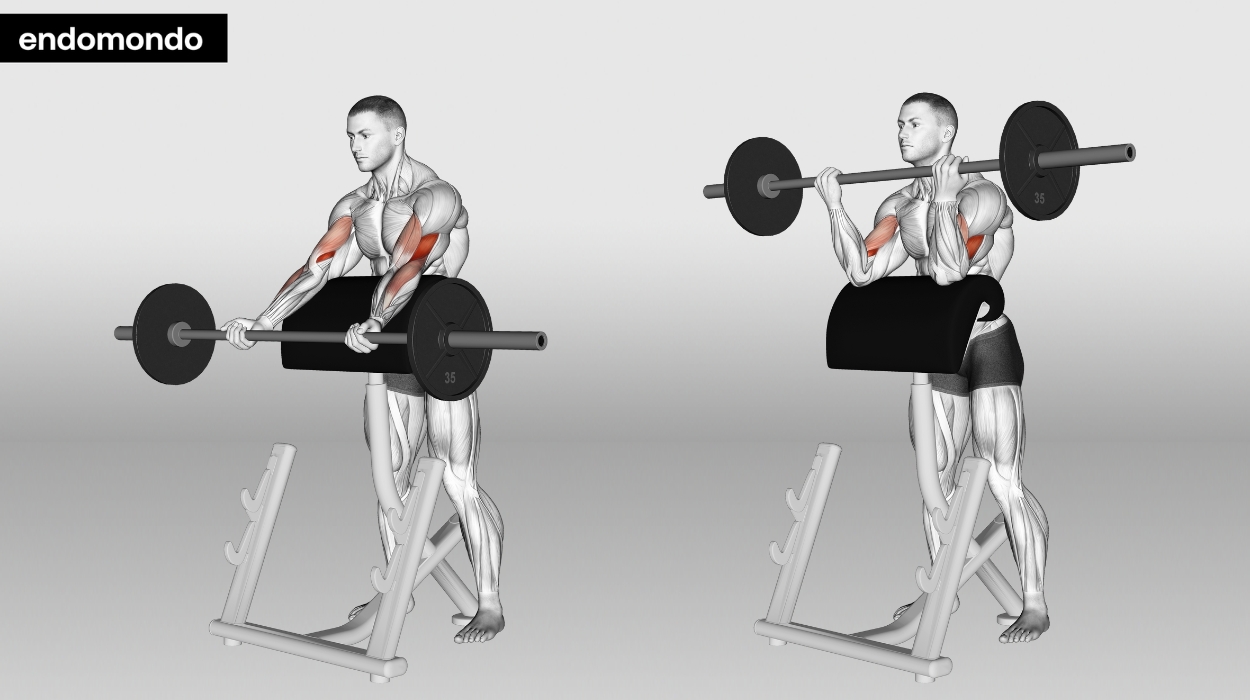
How to do:
- Set the incline bench to 45 degrees and lie face down. The bench should support your chest.
- Lift the bar from under the bench using your forearm muscles and hold it with an underhand grip and arms straight.
- Curl the barbell up towards you, squeezing your biceps at the top.
- Lower the barbell back down with control.
Tips:
- Ensure your chest and upper arms are firmly supported on the bench to isolate the biceps effectively.
- Keep your elbows stationary and close to the bench while curling the barbell.
- Use an underhand grip (palms facing up) on the barbell with your hands positioned slightly wider than shoulder-width apart to target the biceps and brachialis muscles.
Optimal Sets and Reps: 3 to 4 sets of 6-8 reps.
Barbell Preacher Curl
This barbell curl isolates the bicep brachii, allowing for a more targeted and effective bicep workout.
By incorporating this exercise into your barbell arm workout, you can effectively build and define your biceps, helping to create that sought-after peak. It also aids in improving biceps strength and endurance, which can enhance your performance in other lifting exercises. Overall, this exercise contributes to a balanced and impressive arm development, making it a valuable addition to your arm workout routine.
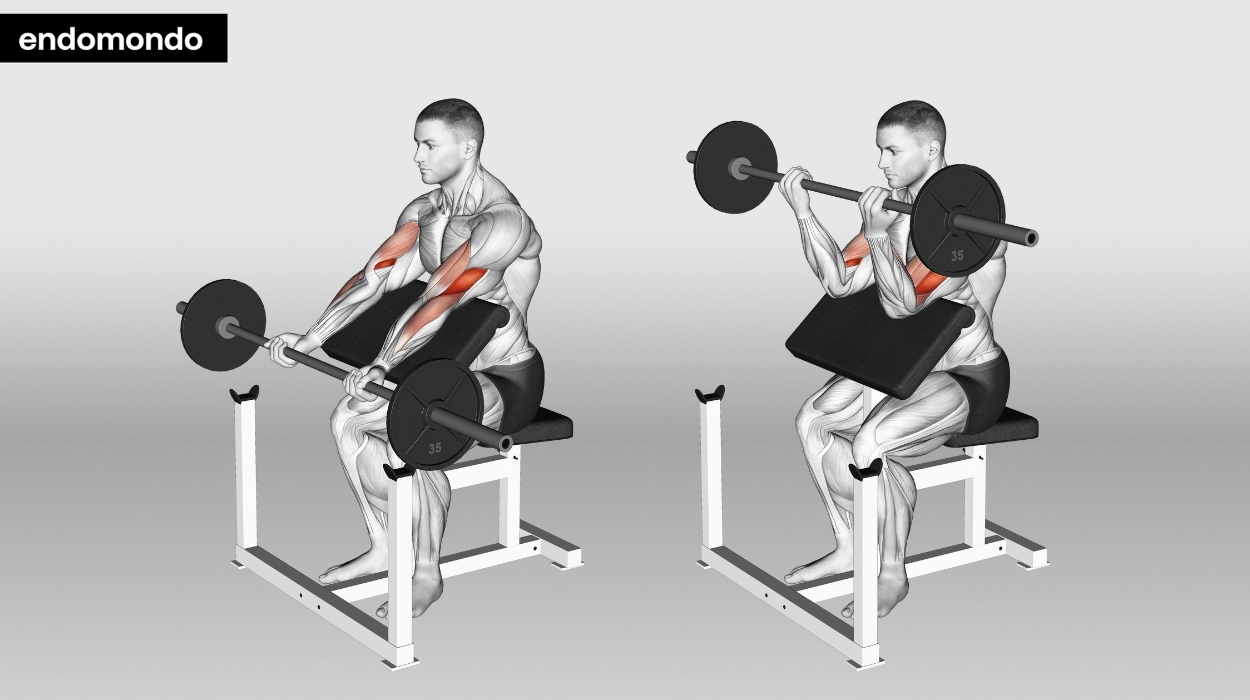
How to do:
- Adjust a preacher curl bench so your armpits rest comfortably on the pad.
- Hold the bar with your palms facing up and let your arms hang straight down.
- Curl the barbell towards your shoulders. Keep your elbows and upper arms stationary.
- Lower the barbell back down in a controlled manner.
Tips:
- Maintain strict control throughout the movement to target the biceps effectively.
- Avoid arching your back excessively during the exercise; instead, keep your spine neutral and core engaged to prevent strain on your lower back.
- Choose a weight that allows you to perform the exercise with proper technique.
Optimal Sets and Reps: 3 to 4 sets of 8-12 reps with moderately heavy weight.
Barbell Biceps Curl
Barbell curls can help you achieve impressive gains in the biceps muscles. The standard barbell curl is one of the most popular exercises for building arm strength and size.
Barbell biceps curls can be easily incorporated into any strength training routine for well-developed and defined biceps, enhancing the aesthetic appeal of your arms. Additionally, stronger biceps contribute to improved performance in various lifting and pulling movements, making it a valuable exercise for overall upper body strength.
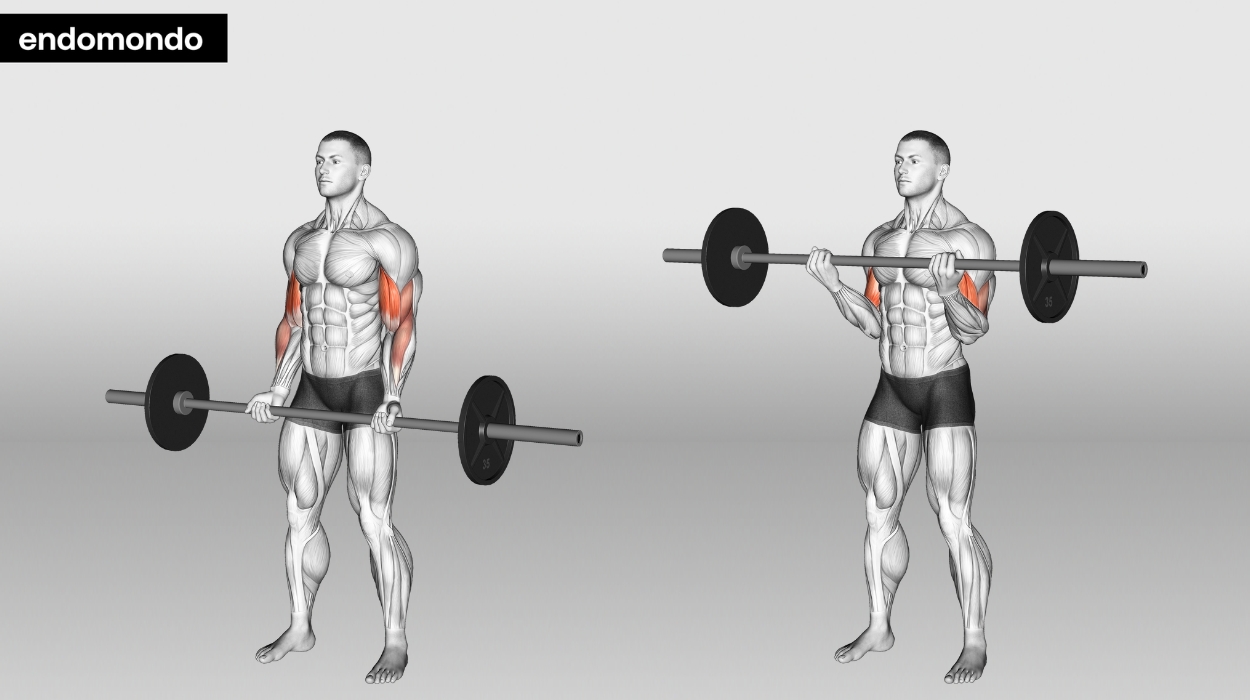
How to do:
- With your feet shoulder-width apart, stand holding the barbell with palms up.
- Let your arms hang with your elbows close to your sides.
- Slowly curl the barbell upwards towards your shoulders.
- Slow and controlled, lower the barbell back to the starting position.
Tips:
- Keep your elbows close to your sides throughout the movement to avoid straining the shoulder joints.
- Avoid swinging your body or using momentum to lift the barbell.
- Ensure your back remains straight and your core is engaged.
Optimal Sets and Reps: 3 to 5 sets of 6-8 reps.
Overhead Barbell Triceps Extension
These tricep exercises primarily target the triceps, which help develop stronger and more defined upper arms.
This exercise can help you achieve well-defined and powerful triceps. Strong triceps are essential for various upper body movements, including pushing exercises like bench presses and overhead presses. It also enhances overall arm strength and contributes to a balanced and sculpted appearance. Whether you’re aiming for improved athletic performance or aesthetics, the overhead barbell triceps extension is a valuable addition to your workout routine.
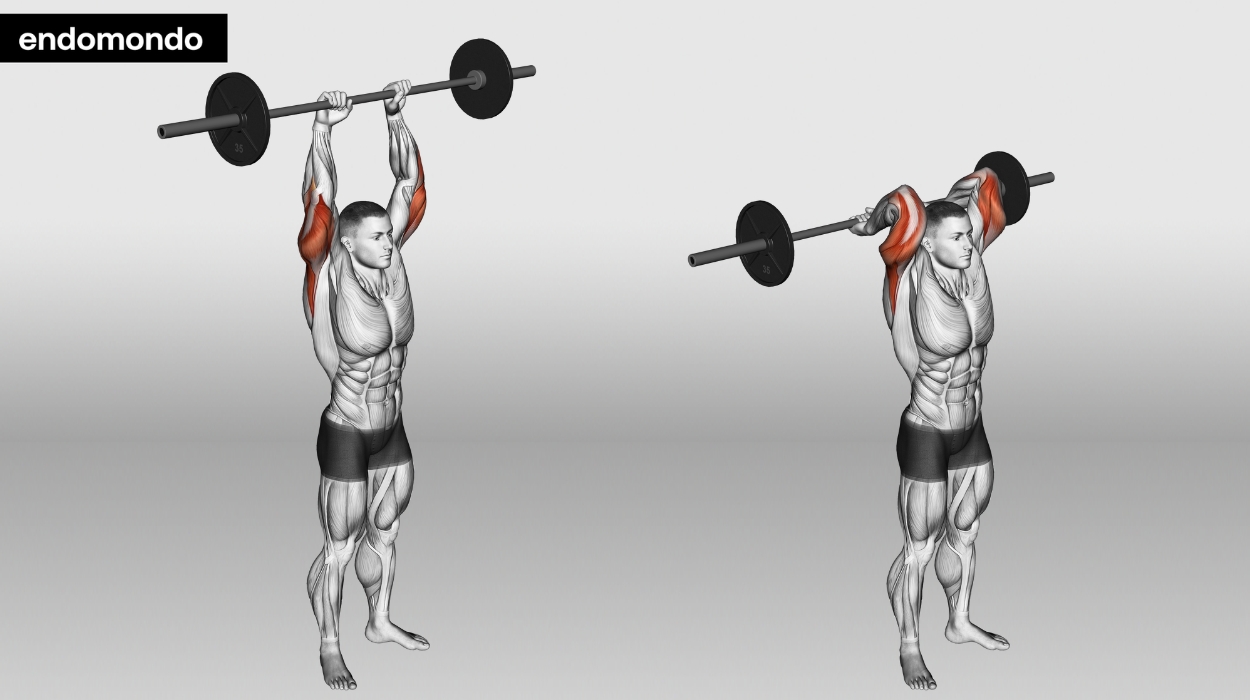
How to do:
- Stand with your feet flat and hip-width apart.
- Hold the barbell with palms facing down.
- Raise the barbell over your head with fully extended arms.
- Keep your triceps straight and bend your elbows as you lower the barbell behind your head. You should feel a stretch in your triceps.
- Straighten your arms to return to the starting position.
Tips:
- Hold the barbell with a narrow, overhand grip (hands closer together) to target the triceps effectively.
- Avoid using excessive weight, which can compromise form and strain the elbows.
- Keep your elbows close to your head throughout the movement as this helps isolate the triceps and reduces stress on the shoulder joints.
Optimal Sets and Reps: 2 to 4 sets of 8-10 reps.
Barbell Hammer Curl
Hammer curls emphasize the forearm muscles, primarily targeting the brachialis muscle, which is situated underneath the biceps. Doing hammer curls with a barbell contributes to overall arm development and grip strength.
Strengthening the brachialis enhances the overall appearance of your arms by creating a fuller and more defined look. Additionally, the exercise improves functional strength, aiding in various pulling and lifting movements.
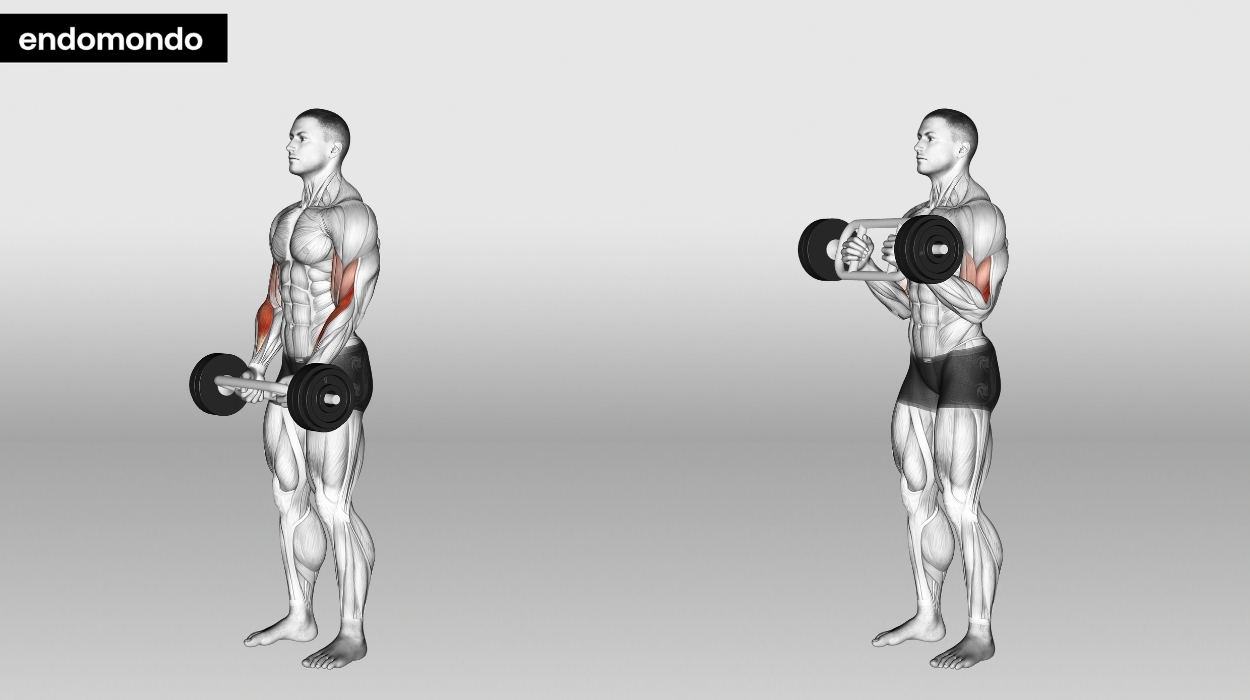
How to do:
- For this biceps curl, you will need an Olympic parallel barbell.
- Place your feet shoulder-width apart and stand holding the barbell with your hands grasped and palms facing one another.
- Curl the barbell toward your shoulders, keeping your elbows tucked to your sides.
- Lower the barbell back down with control.
Tips:
- Maintain a stable, upright posture with your chest up and shoulders back.
- Avoid using your back or shoulders to lift the weight; instead, focus on the contraction of the forearm muscles.
- Choose a suitable weight that allows you to perform the exercise with proper technique.
Optimal Sets and Reps: 2 to 3 sets of 8-12 reps.
Benefits Of Arm Workouts
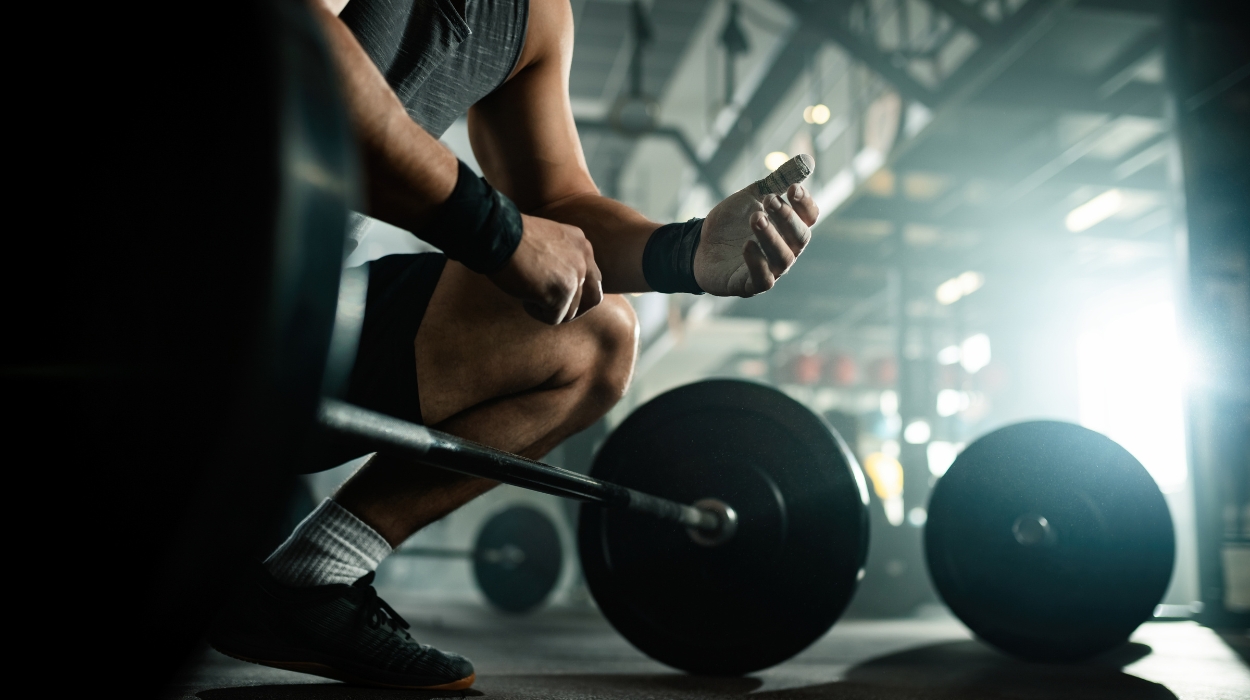
- Improved heart health – Exercises that raise your heart rate can help reduce excess fat and improve heart health. A recent study[1] suggests that strength training may be better at reducing fat around the heart than cardio exercises.
- Improves running efficiency – Engaging in arm exercises may help improve running efficiency.[2] Head stability while running increases as arm and shoulder muscles become stronger.
- Better bone density – Weight-bearing arm exercises, such as resistance training with dumbbells or barbells, stimulate bone health by putting stress on bones. This encourages the body to build more bone structure. This helps improve bone density[3] and reduce osteoporosis risk.
- Ease joint pain and stiffness – Strengthening the muscles around your joints, including the shoulder blades and elbow joints, helps stability and reduces stress on the joints. This helps alleviate joint pain and stiffness,[4] particularly for individuals with osteoarthritis.
- Boosts metabolism – Muscle tissue requires more energy to maintain than fat tissue. Your metabolism increases as you engage in arm exercises and build lean muscle mass, leading to more efficient calorie burning, even at rest.
- Reduces stress – Physical activity, like arm exercises, triggers endorphins[5] – the body’s natural feel-good chemicals. Endorphins can help reduce stress, anxiety, and depression. People who exercise regularly tend to be less affected by stress[6] and better able to manage tough times.
- Enhanced quality of life – Arm exercises can help improve daily activities like lifting, carrying, and performing household tasks. This can help improve your overall quality of life and independence.
Safety Tips
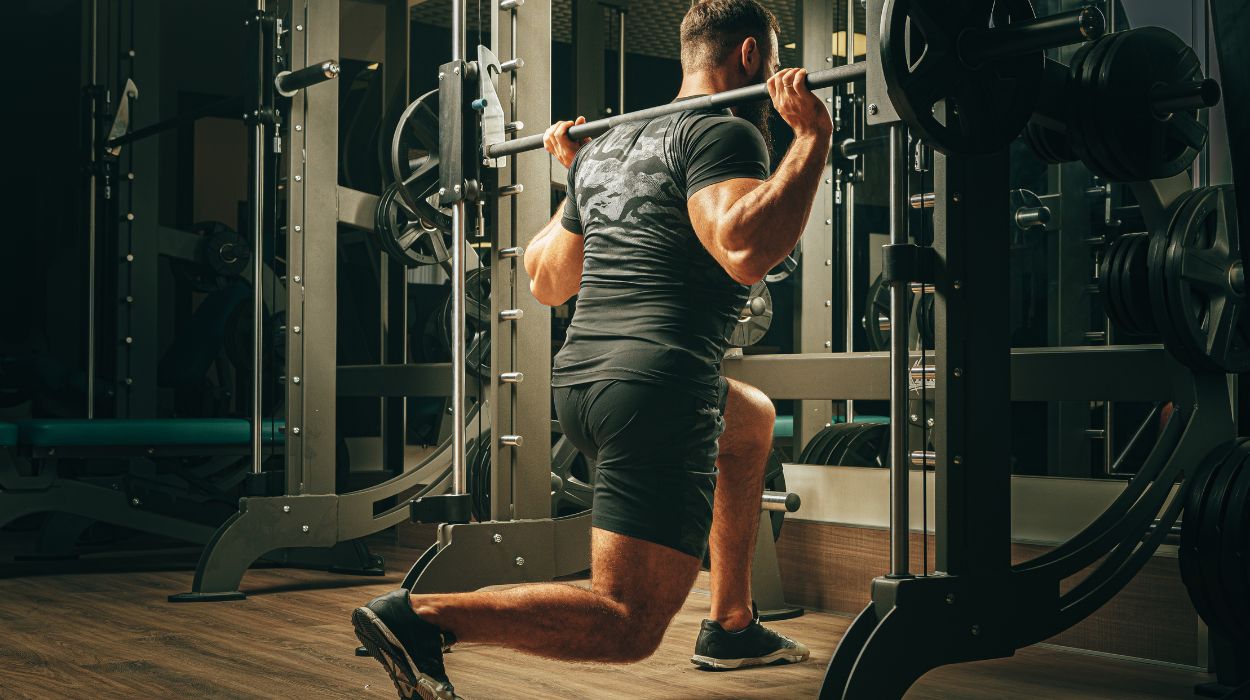
Safety is key when performing barbell arm workouts to prevent injuries and ensure an effective workout. Here are some essentials to remember:
- Warm up properly – Always begin your workout with a warm-up to increase the blood flow to the muscles and prepare them for exercise.
- Choose appropriate weight – Select a weight that allows you to perform the exercises with proper form and control. How much weight depends on what the barbell weighs. Barbells vary from 15-45 lbs, depending on the type.
- Maintain proper form – Focus on maintaining correct form throughout each repetition. Improper form reduces the effectiveness. Seek guidance from a certified personal trainer if you need clarification on the proper technique. And remember, slow and controlled is key.
- Start with low intensity – If you are new to barbell arm exercises, start with lower weights. Gradually increase the intensity as your abilities and comfort level increase.
- Use a spotter for heavy lifts – If you’re lifting heavy weights, especially during exercises like the barbell close-grip bench press, it’s advisable to have a spotter to assist you. A spotter can provide support during challenging sets and help you safely rerack the barbell.
- Breathe properly – Remember to breathe throughout each exercise. Exhale when you lift the barbell and inhale while lowering it.
- Pay attention to your body – Always listen to your body. Immediately stop your workout if you have intense pain or discomfort. Pushing through pain can lead to injury.
- Rest and recover – Give your muscles adequate time to recover between workouts. Overtraining leads to fatigue and increases your risk of injuries.
Conclusion
A barbell upper body workout offers a practical approach to sculpting and strengthening your arms, similar to a dumbbell arm workout. Incorporating exercises like the barbell bicep curl, close-grip bench press, and overhead triceps exercises can provide impressive results.
Adding one of these barbell bicep exercises into your dumbbell arm workout routine at home can add a new level of challenge. Consider adding a kettlebell workout, lower ab workouts, or these core exercises to build muscle and keep your fitness journey exciting.
Remember, a balanced and diverse approach can strengthen your core, improve your overall wellness, and transform your fitness journey!
Frequently Asked Questions
Yes, barbells are excellent for arms. They effectively target the biceps, triceps, and forearms to increase muscle development and strength.
Barbell exercises can effectively target and develop the biceps. Incorporating various arm exercises with different equipment can provide a more well-rounded and comprehensive arm workout.
Barbell exercises can be suitable for beginners to build strength and improve overall fitness under proper guidance. You should always start with lighter weights and focus on proper form to prevent injuries.
It’s not advisable to do barbell exercises every day. You should allow the muscles time to rest and recover to prevent overtraining and reduce the risk of injury. Aim for a balanced workout routine with rest days.
Resources
- Regitse Højgaard Christensen, Anne Sophie Wedell-Neergaard, Louise Lang Lehrskov, Grit Elster Legaard, Dorph, E., Monica Korsager Larsen, Natja Launbo, Sabrina Ravn Fagerlind, Sidsel Kofoed Seide, Stine Nymand, Ball, M., Vinum, N., Camilla Nørfelt Dahl, Henneberg, M., Mathias Ried‐Larsen, Boesen, M., Christensen, R., Karstoft, K., Rikke Krogh-Madsen and Rosenmeier, J.B. (2019). Effect of Aerobic and Resistance Exercise on Cardiac Adipose Tissues. JAMA Cardiology, [online] 4(8), pp.778–778. doi:https://doi.org/10.1001/jamacardio.2019.2074.
- Yegian, A.K., Tucker, Y., Bramble, D.M. and Lieberman, D.E. (2021). Neuromechanical linkage between the head and forearm during running. American Journal of Physical Anthropology, [online] 174(4), pp.752–762. doi:https://doi.org/10.1002/ajpa.24234.
- A Ram Hong and Sang Wan Kim (2018). Effects of Resistance Exercise on Bone Health. Endocrinology and Metabolism, [online] 33(4), pp.435–435. doi:https://doi.org/10.3803/enm.2018.33.4.435.
- Latham, N.K. and Liu, C. (2010). Strength Training in Older Adults: The Benefits for Osteoarthritis. Clinics in Geriatric Medicine, [online] 26(3), pp.445–459. doi:https://doi.org/10.1016/j.cger.2010.03.006.
- Basso, J.C. and Suzuki, W. (2017). The Effects of Acute Exercise on Mood, Cognition, Neurophysiology, and Neurochemical Pathways: A Review. Brain plasticity, [online] 2(2), pp.127–152. doi:https://doi.org/10.3233/bpl-160040.
- Childs, E. and Harriet de Wit (2014). Regular exercise is associated with emotional resilience to acute stress in healthy adults. Frontiers in Physiology, [online] 5. doi:https://doi.org/10.3389/fphys.2014.00161.




